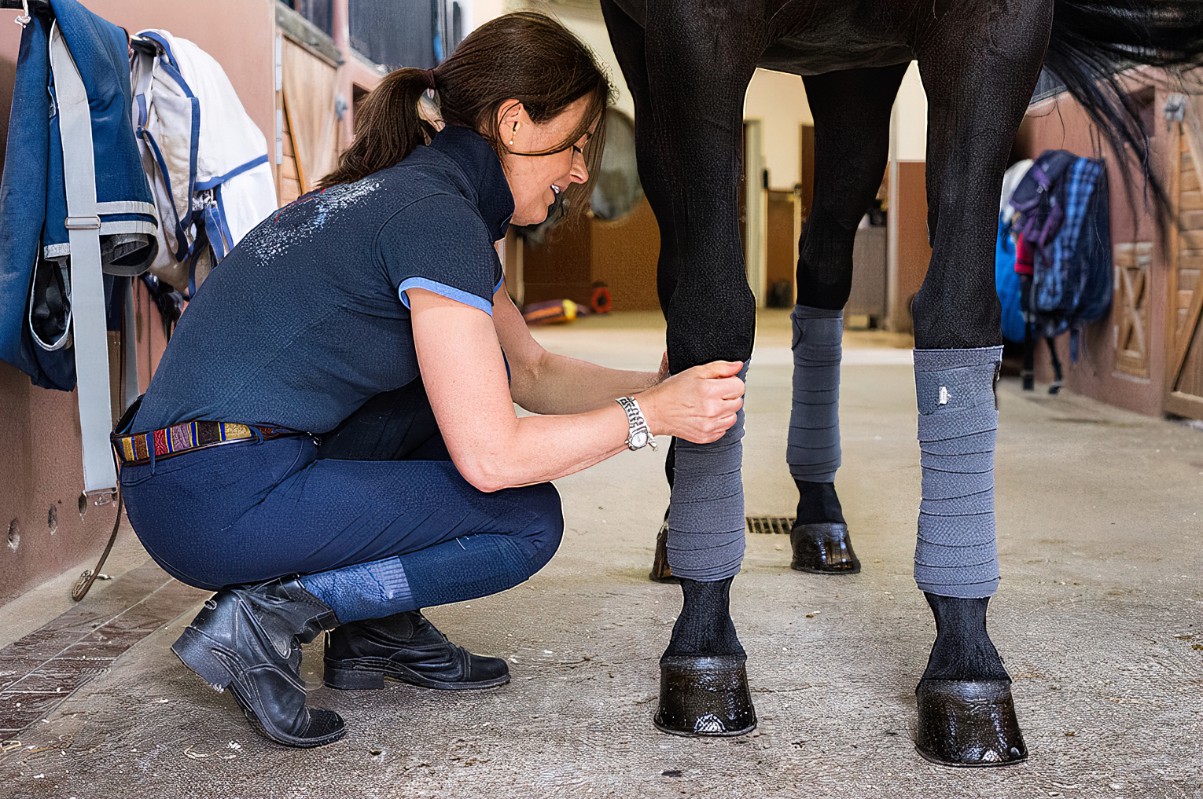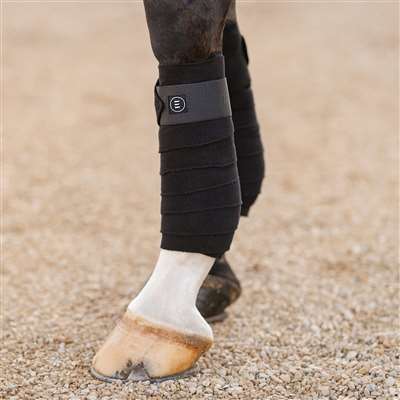How to Use Polo Wraps for English Horses: The Ultimate Guide
What is the purpose of polo wraps?
Polo wraps are a type of bandage or leg wrap for horses. They are made of a thick, stretchy material and can be used to protect the horse's legs from injury while longing, and turnout. In our guide, we will discuss how to use polo wraps for English horses. We will go over the different ways that they can be used, as well as the benefits that they provide. Polo wraps are typically used for three purposes: for support while riding, to protect the horse's legs from injury, and to keep the legs clean. They are often wrapped around the fetlock area and cannon bone. This helps to prevent injuries such as scrapes and bruises. Polo wraps can also be used to protect the horse's legs from being clipped.
Which horse disciplines use polos as horse leg wraps?
As far as we know all disciplines use polo wraps to protect their horse's legs. From western pleasure horses to racehorses to barrel racing horses to roping horses to polo wraps for cutting horses to dressage horses to hunter and jumper horses, polo wraps are found in all the horse trainers' and Equestrians tack rooms.
Polo wraps are used by many horse disciplines. They are easy to use and keep sanity. Polo wraps protect against minor scrapes and bruises and help prevent irritation from sand or arena footing. Usually, polos are used without any padding underneath.
Some common horse activities polo wraps are used in include:
- Riding horses of all disciplines both English and western. Polos are applied to ride and school horses. Polo wraps are an essential part of riding schooling dressage horses. They are used for lunging and schooling show hunters and taken off just before entering the show arena. The showjumpers divisions allow the use of polos in competition, however, most riders opt for boots, as they provide better protection.
-
Longeing or lunging horses. Polos are also commonly to protect horses' legs while longeing.
-
Shipping horses can be used to ship in polos for protection; but, it can be dangerous as the wraps are too flexible and can shift and cause serious problems. Traditional standing wraps are preferable.
-
Turning out horses. While some people turn out their horses in polo wraps, it's not common because they can come loose, pick up weeds, and can soak in water.
What are advantages of Polo Wraps over Horse boots?
 Polo wraps are considered an essential piece of tack for any Dressage and English rider. Not only do they keep your horse's legs protected from bumps and scrapes, but they also help to prevent chafing and rubbing. Polos provide protection to the tendons and joints and protect them from scrapes and accidental overreaching with the hind legs.
Unlike regular horse boots, polos conform to a horse's leg. Polos cover a more surface area of the horse's leg compared to horse boots. Because of their flexibility they can be used and provide slightly more protection in one area of the leg. Depending on length and width; a polo wrap can be used on most sizes of horses, cob-sized, and some ponies. Pony polo wraps are normally packaged in sizes to fit short pony cannon bone legs. Polos are often the alternative for a horse that cant wear traditional horse boots: a horse with cuts or damage that will rub with a boot, or a horse with neoprene allergies. Polos also give the horse and rider a classy look.
There are many different ways to use polo wraps, and each rider has their own preferences. However, there are some general tips that can help you get the most out of your polo wraps.
What are hose boot alternatives to polo wraps?
There are several English horse boot alternatives to polo wraps, each with its own advantages. One popular alternative is the "no-wrap" boot, which as the name suggests, does not require any wrapping. These boots are easy to put on and take off and provide good coverage and protection for your horse's legs.
Another leg protection piece that compliments polo wraps is Bell Boots, which is a boot that covers the entire hoof and provides extra protection against chafing and rubbing. Whichever type of boot you choose, make sure it fits your horse well and is comfortable for them to wear. Horse boots such as brushing boots and hard shell galloping boots provide protection. Sports medicine boots with neoprene can also provide support to the tendons and ligaments. General splint boots help protect the splint boots and are easy to use. Dressage boots are also an easy alternative to polo wraps.
Are there disadvantages of polo wraps?
Polo wraps cover the horse's tendons and ligaments. They are put on by riders and if not trained an incorrect wrap with uneven distribution of polo wrap tension being too tight will damage the horse's tendons. Polo wraps too loosely or the velcro is weak can work as a tourniquet and is very dangerous. Polos can also be pulled down and tightened around the tendons if a horse were to step on himself while wearing them.
Polos take longer to apply than regular horse boots. They need to be washed frequently to stay clean and free of dried sweat and arena sand. Polos do not work in wet conditions because they absorb water; get heavy and will sag.
The perfect polo wrap, how to wrap a horses leg?Equestrians have different ways to wrap polo wraps. Some riders start the wrap at the top of the leg and wrap the horse's leg evenly down and then back up. The wrap is started on the inner leg and slightly snugged while coming forward around the front of the leg and being careful not to tighten too much going around the back of the leg. Coming back over itself mid-way and evenly. Going down the leg until you come to the fetlock. Some riders cross-sling like under the fetlock for support and then back to the top. t does provide a limited amount of protection to the joint from scrapes, bruises, and accidental overstep with the hind legs ("overreaching").
When applying polo wraps prevent any gaps that could allow for rubs or chafing. It's also important to make sure that the wraps are not too tight or too loose. If they're too tight, they can cut off circulation to the horse's legs. No matter how the wrap is applied, the tension in the wrap should be as uniform as possible across the entire leg. Uneven pressure may cause damage to tendons. Additionally, the pressure on one leg should be comparable to the pressure on the leg on the other side; otherwise, gait abnormalities may result. Conventional wisdom holds that because no two people wrap with exactly the same tension, the same person should wrap the right and left legs.
How do you clean polo wraps?
The best way to clean polo wraps is to put them in a mesh bag and machine wash them on the delicate cycle. We recommend a mesh bag as the velcro can catch in the washer and dryer. Use a mild detergent as these go against your horse's legs. For white polo wraps, you can add a cap full of bleach. You have to be careful about drying them so they don't shrink. Some people hang dry or dry on delicate. Other people want the wraps to shrink so they dry on high heat.
Ok, we all know how to wash polo wraps. But, how do you clean them if you get them dirty at a horse show?
We all know the feeling. You're out at a horse show and your horse's polo wraps are covered in mud. What do you do? If you're like most people, you probably don't have a lot of experience washing polo wraps. But don't worry, we're here to help! Here are some tips for cleaning your polo wraps:
- First, make sure you have a large enough tub or container to soak your polo wraps in. Have enough water to completely submerge the wraps.
- Next, add some gentle detergent to the water. We recommend using a mild soap like Woolite or Ivory Soap and avoid using harsh detergents.
- Once the detergent has been added, let the wraps soak for about 30 minutes. This will give the soap time to work its way into the fabric and loosen any dirt or stains.
- After 30 minutes, take the wraps out of the water and rinse them thoroughly. You may need to rinse them several times to remove all of the soap.
- Once the wraps are rinsed hang to dry. Make sure they're completely dry before reuse.
Tack Warehouse, shop your favorite brands of polo wraps
There are many companies that make polo wraps. They generally come 4 to a set. These are the first line of protection for your horse's legs so it's important to invest in a quality pair. The Tack Warehouse buyers look for the best polo wraps for horses that have wide Velcro straps that match the color of the material. So white polo wraps with white velcro for a clean look. We like the off-the-shelf polo wraps that come in great colors and are made by Classic Equine polo wraps and Weaver leather with sunfloer polowraps, cheetah polo wrap, zebra polo wrap, and sunflower polo wraps, and leopard print polo wraps. Traditional English polo wrap brands we like are Professional's Choice polo wraps, Equine Textiles brands are wide and cushy and hold up, Vacs bandages are a race track favorite. Back on Track Polo wraps provide a ceramic therapeutic material. EquiFit Horse T-Sport Wrap. Catago polo wraps make a hybrid support wrap that is supportive and popular. Then there are the fancy large fluffy fleece Dressage brands made to match saddle pads from brands like Schockemohle, Equestrian Stockholm, LeMieux, PS of Sweden...
We hope these tips help you keep your polo wraps clean and looking their best!
|